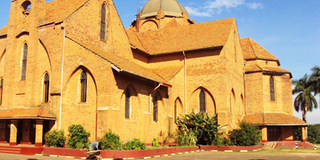Prime
Age takes its toll on Namirembe Cathedral

Wooden planks on the cathedral’s dome are rotten while copper plates need to be fixed with screws. Algae is growing on the walls as a result of leakages. PHOTOS BY JOHN K. ABIMANYI.
It stands out as that red-tiled building spearing through the greenery that surrounds it like a lighthouse by the sea. It sits there quietly, in peaceful observance of time, living out the meaning of the name of the hill on which it’s built– Namirembe, the place of peace.
It has stood there for 95 years now, and a further 29 if you consider the earlier churches that were destroyed to allow for its construction. All that while, it has been the ultimate place of worship for many Christians; the provincial seat of the Anglican Church in Uganda.
Needs repair
But now, the weight of the years it has lived has started to make its mark on the cathedral, and those marks have started to come out of hiding. The church’s roof, made of colourful bright-red tiles, is now leaking and it is leaking terribly, especially down through the dome.
Many of these tiles have been lodged out of their sockets, allowing water to easily seap through and drop on the faithful down below. Algae and a series of other plantings have raised their heads straight through the crevices in the walls, protruding like crops through the soil. The wall tiles that once shone are now discoloured by rainwater. St Paul’s Cathedral Namirembe is now in urgent need of repair.
And the church is only too aware of this need. For this, the church sought a remedy by enlisting engineering consultants to assess the state of the building and point out the parts in need of repair. Last month, KK Consultants tabled their findings before the cathedral’s bishop, Wilberforce Kityo Luwalira.
Architectural findings
The findings from the architects suggested that a massive repair for the entire cathedral was long overdue. Many of the battens, the pieces of wood on which the roof tiles sit, had been eaten up by termites. The tiles were broken and thus unable to give cover from the rain. Also, the copper leaves that are joined to form the beaconing dome with a cross on top were found to have withered with some nails that are supposed to join them, missing.
The report found the church not completely safe from lightning attacks as the lightning conductors were loose and sagging, the second cathedral was destroyed by a fire from a lightning strike in 1910. The church also lacks a polythene or iron sheet layer to trap any water that escapes through the roof, prompting Mr Phyllis Kwesiga, one of the consulting engineers to say, “Almost the entire church is leaking.”
But the bad news does not end with the structure. Its electric wiring was described as “dangerous” because the wires are untidily placed on the surface. The report said there was no earthing for the electricity and, that the church has only one fire extinguisher that was last serviced in 2003.
Efforts made
It is with such findings that Bishop Luwalira noted, “This is a timely project.” With the findings done, the church is now seeking Shs1.7b to start the repairs.
The committee overseeing the repairs is called Ttegula Project. Mr Stephen Lwanga, the projects treasurer, says the church has so far collected Shs300m. It now calls for donations to help reach the Shs1.7b target. “If in this day and age we fail to repair the cathedral, it would be very bad. We cherish this cathedral. We have heard what needs to be repaired and the work is now on our side,” Bishop Luwalira says. The repairs are to be done in three phases, dealing with the roof first, the floors and walls second and then external works.
Importance of Namirembe Cathedral
The reaction to the need for repairs goes to symbolise the importance of Namirembe Cathedral as more than just another church, as a sacred site to which is attached personal, spiritual, cultural and national importance. And it’s thus no wonder that this drive has brought the best out of concerned parties that wish the church well. “Some people from different religious affiliations including Muslims, have given money to the project,” Mr Lwanga says.
According to Mr Samuel Busulwa, the academic registrar at Nkumba University and former head teacher of Kings College Budo, Namirembe Cathedral is a part of his life. “I have grown up in this cathedral. Since 1954, I have been here. I even married in this church. It has very beautiful architecture and its name signifies peace. So, we want to restore it to its rightful shape. It should not collapse in our time.
Attachment to Buganda
Namirembe Cathedral especially stands for its connection to Buganda Kingdom. Buganda Kingdom’s spokesperson, Mr Charles Peter Mayiga, says, “The Kabaka is the patron of Namirembe Cathedral. The church is very important to the kingdom because it was built on land given by the Kabaka, way back in the past centuries,” he says.
He adds that it is one of the hills where the Kabaka used to conduct his work and where peace was negotiated. Also, the first royal Christian wedding between Kabaka Daudi Chwa and Priscilla Namaganda took place there on September 19, 1914.
Historical site
It’s importance goes beyond Buganda to include Uganda as a whole. The Historic Buildings Conservation Trust lists it among Uganda’s historic sites. The Rev. Canon Magala says the cathedral receives tourists from abroad plus a stream of native visitors, especially students, as visitors to the site. “It is one of the oldest churches in the East African region,” he says.
Within the cathedral are burial grounds where leading figures in Uganda’s history are rested. These include Dr Albert and Catherine Cook who started Uganda’s first hospital at Mengo and Bishop Hannington and Alexander Mackay, both missionaries. The cathedral’s dean says the burial grounds are meant for people who have made distinguished services to Namirembe diocese and to bishops and their wives. As KK Consultants presented their findings to Ttegula Project and mentioned the possibility of altering the higher sections of the wall to add ventilation, a sense of concern became evident among the members.
This will not be the first time that the cathedral is undergoing repair, but it will by far be the biggest of its kind. The repair of St Paul’s Cathedral, Namirembe could thus provide a tutorial to Uganda as a whole on just how such ancient sites should be treated, a reason as to why no society should ever allow itself to pass-on a collection of ruined, tattered and dilapidated heritage to its next generation.
Namirembe Cathedral at a glance
* The first church was constructed at Kitesa on Namirembe hill by the Church Missionary Society (CMS) in 1890. Its architect was Nicodemo Sebwato, the chief of Buddu.
* The second church, which became the first cathedral, constructed in 1892 at the top of the hill, was blown away by the wind during a heavy storm in 1894.
* Daudi Chwa laid the foundation stone for the second cathedral. It was made of burnt bricks and sun dried walls; a mixture of Ganda and Euro architecture. Lightning and fire struck it in September 23, 1910.
* The present structure was designed by Arthur Bereford Pite, a professor of Architecture in England, at the request of Bishop Tucker. Preparation work of digging 1.5metre deep trenches took four years.
Construction involved many natives with the people donating bricks for the construction. It was built during the First World War and completed in 1919.
Outstanding features
* Eagle lectern donated by then colonial government in memory of the people that had died in World War I.
* Cathedral organ purchased from the Positive Organ Company in 1922. Peter Wells, an organ repairer from the UK, services it at the beginning of every year. The special sound of the organ has increased the cathedral’s demand for people to have weddings there.
* Has a burial ground where missionaries and bishops are rested. Also, it can seat more than 3,000 worshippers.
* The Bishop’s throne, standing between the altar and the choir, was constructed by the students of Kings College Budo.
Memorable events
* The wedding of Kabaka Daudi Chwa.
* The wedding of Kabaka Sir Edward Muteesa II.
* The wedding of Dr Apollo Milton Obote.
* The wedding of Kabaka Ronald Muwenda Mutebi
Compiled by John Abimanyi




